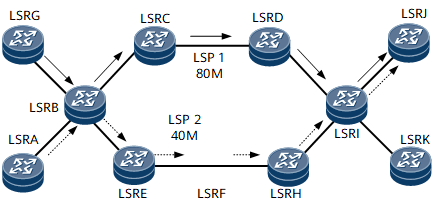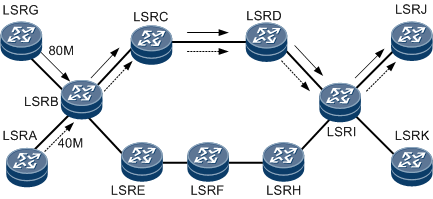Overview of MPLS TE
Multiprotocol Label Switching (MPLS) traffic engineering (TE) effectively schedules, allocates, and utilizes existing network resources to provide sufficient bandwidth and support for quality of service (QoS). MPLS TE helps carriers minimize expenditures without requiring hardware upgrades. Because MPLS TE is implemented based on MPLS, it is easy to deploy and maintain on existing networks. MPLS TE supports various reliability techniques, which help backbone networks achieve carrier and device-class reliability.
Definition

Function Module |
Description |
|---|---|
Basic function |
Basic MPLS TE functions include basic MPLS TE settings and the tunnel establishment capability. |
Tunnel optimization |
Tunnel optimization allows existing tunnels to be reestablished over other paths if the topology is changed, or these tunnels can be reestablished using updated bandwidth if service bandwidth values are changed. |
Reliability |
MPLS TE provides various reliability functions, including path protection, local protection, and node protection. |
Security |
RSVP authentication is implemented to improve the security of the signaling protocol on the MPLS TE network. |
P2MP TE |
P2MP TE is a promising solution to multicast service transmission. It helps carriers provide high TE capabilities and increased reliability on an IP/MPLS backbone network and reduce network operational expenditure (OPEX). |
Purpose
TE techniques are common for carriers operating IP/MPLS bearer networks. These techniques can be used to prevent traffic congestion and uneven resource allocation. Take the network shown in Figure 2 as an example.
A node on a conventional IP network selects the shortest path as an optimal route, regardless of other factors, for example, bandwidth. This easily causes the shortest path to be congested with traffic, whereas other available paths are idle.
Each Link on the network shown in Figure 2 has a bandwidth of 100 Mbit/s and the same metric value. LSRA sends LSRJ traffic at 40 Mbit/s, and LSRG sends LSRJ traffic at 80 Mbit/s. Traffic from both routers travels through the shortest path LSRA (LSRG) → LSRB → LSRC → LSRD → LSRI → LSRJ that is calculated by an IGP. As a result, the path LSRA (LSRG) → LSRB → LSRC → LSRD → LSRI → LSRJ may be congested because of overload, whereas the path LSRA (LSRG) → LSRB → LSRE → LSRF → LSRH → LSRI → LSRJ is idle.
Network congestion is a major cause for backbone network performance deterioration. The network congestion is resulted from insufficient resources or locally induced by incorrect resource allocation. For the former, network device expansion can prevent the problem. For the later, TE is used to allocate some traffic to idle link so that traffic allocation is improved. TE dynamically monitors network traffic and loads on network elements and adjusts the parameters for traffic management, routing, and resource constraints in real time, which prevents network congestion induced by load imbalance.
IP traffic engineering: It controls network traffic by adjusting the metric of a path. This method eliminates congestion only on some links. Adjusting a metric is difficult on a complex network because a link change affects multiple routes.
ATM traffic engineering: It uses an overlay network model and sets up virtual connections to guide some traffic. The overlay model provides a virtual topology over the physical topology of a network, which facilitates proper traffic scheduling and QoS. However, the overlay model has high extra overhead, poor scalability, and high operation costs for carriers.
Benefits
- Provides bandwidth and QoS guarantee for service traffic on the network.
- Optimizes bandwidth resource distribution on the network.
- Establishes public network tunnels to isolate virtual private network (VPN) traffic.
- Is easy to deploy and maintain as it is implemented based on existing MPLS techniques.
- Provides various reliability functions to implement carrier- and device-class reliability.
